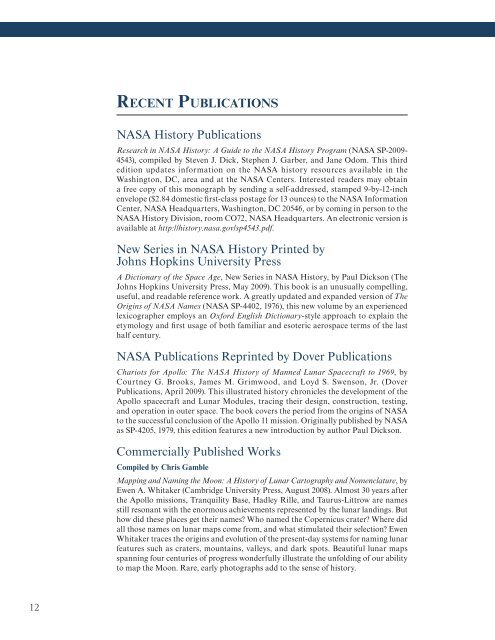FROM THE CHIEF HISTORIAN BORIS CHERTOK'S Rockets and ...
FROM THE CHIEF HISTORIAN BORIS CHERTOK'S Rockets and ...
FROM THE CHIEF HISTORIAN BORIS CHERTOK'S Rockets and ...
Create successful ePaper yourself
Turn your PDF publications into a flip-book with our unique Google optimized e-Paper software.
nasa history division<br />
12<br />
reCent PuBliCations<br />
NASA History Publications<br />
Research in NASA History: A Guide to the NASA History Program (NASA SP-2009<br />
4543), compiled by Steven J. Dick, Stephen J. Garber, <strong>and</strong> Jane Odom. This third<br />
edition updates information on the NASA history resources available in the<br />
Washington, DC, area <strong>and</strong> at the NASA Centers. Interested readers may obtain<br />
a free copy of this monograph by sending a self-addressed, stamped 9-by-12-inch<br />
envelope ($2.84 domestic frst-class postage for 13 ounces) to the NASA Information<br />
Center, NASA Headquarters, Washington, DC 20546, or by coming in person to the<br />
NASA History Division, room CO72, NASA Headquarters. An electronic version is<br />
available at http://history.nasa.gov/sp4543.pdf.<br />
New Series in NASA History Printed by<br />
Johns Hopkins University Press<br />
A Dictionary of the Space Age, New Series in NASA History, by Paul Dickson (The<br />
Johns Hopkins University Press, May 2009). This book is an unusually compelling,<br />
useful, <strong>and</strong> readable reference work. A greatly updated <strong>and</strong> exp<strong>and</strong>ed version of The<br />
Origins of NASA Names (NASA SP-4402, 1976), this new volume by an experienced<br />
lexicographer employs an Oxford English Dictionary-style approach to explain the<br />
etymology <strong>and</strong> frst usage of both familiar <strong>and</strong> esoteric aerospace terms of the last<br />
half century.<br />
NASA Publications Reprinted by Dover Publications<br />
Chariots for Apollo: The NASA History of Manned Lunar Spacecraft to 1969, by<br />
Courtney G. Brooks, James M. Grimwood, <strong>and</strong> Loyd S. Swenson, Jr. (Dover<br />
Publications, April 2009). This illustrated history chronicles the development of the<br />
Apollo spacecraft <strong>and</strong> Lunar Modules, tracing their design, construction, testing,<br />
<strong>and</strong> operation in outer space. The book covers the period from the origins of NASA<br />
to the successful conclusion of the Apollo 11 mission. Originally published by NASA<br />
as SP-4205, 1979, this edition features a new introduction by author Paul Dickson.<br />
Commercially Published Works<br />
Compiled by Chris Gamble<br />
Mapping <strong>and</strong> Naming the Moon: A History of Lunar Cartography <strong>and</strong> Nomenclature, by<br />
Ewen A. Whitaker (Cambridge University Press, August 2008). Almost 30 years after<br />
the Apollo missions, Tranquility Base, Hadley Rille, <strong>and</strong> Taurus-Littrow are names<br />
still resonant with the enormous achievements represented by the lunar l<strong>and</strong>ings. But<br />
how did these places get their names? Who named the Copernicus crater? Where did<br />
all those names on lunar maps come from, <strong>and</strong> what stimulated their selection? Ewen<br />
Whitaker traces the origins <strong>and</strong> evolution of the present-day systems for naming lunar<br />
features such as craters, mountains, valleys, <strong>and</strong> dark spots. Beautiful lunar maps<br />
spanning four centuries of progress wonderfully illustrate the unfolding of our ability<br />
to map the Moon. Rare, early photographs add to the sense of history.
















